NCR Corporation
NCR Corporation, previously known as National Cash Register is an American software, managed and professional services, consulting and technology company that also makes self-service kiosks, point-of-sale terminals, automated teller machines, check processing systems, and barcode scanners. NCR had been based in Dayton, Ohio, starting in 1884, but in June 2009 the company sold most of the Dayton properties and moved its headquarters to the Atlanta metropolitan area in unincorporated Gwinnett County, Georgia, near Duluth.[4][5] In early January 2018, the new NCR Global Headquarters opened in Midtown Atlanta near Technology Square (adjacent to the Georgia Institute of Technology).
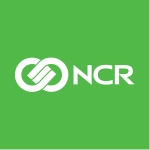 Latest variant of the logo | |
 | |
Formerly | National Cash Register AT&T Global Information Solutions |
|---|---|
| Public | |
| Traded as | NYSE: NCR S&P 400 Component |
| ISIN | US62886E1082 |
| Industry | Information Technology |
| Founded | Dayton, Ohio (1884) incorporation 1900[1] |
| Headquarters | Atlanta, Georgia , |
Key people | Mike (Michael D.) Hayford (CEO) John H. Patterson (Founder) |
| Products | Self-service kiosks, Point of sale, automated teller machines, retail store automation, professional services |
| Revenue | |
| Total assets | |
| Total equity | |
Number of employees | |
| Website | ncr |
NCR was founded in 1884 and acquired by AT&T in 1991. A restructuring of AT&T in 1996 led to NCR's re-establishment on January 1, 1997, as a separate company and involved the spin-off of Lucent Technologies from AT&T.
History
Early years
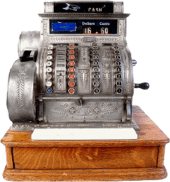
The company began as the National Manufacturing Company of Dayton, Ohio, and was established to manufacture and sell the first mechanical cash register invented in 1879 by James Ritty. In 1884, the company and patents were bought by John Henry Patterson and his brother Frank Jefferson Patterson, and the firm was renamed the National Cash Register Company. Patterson formed NCR into one of the first modern American companies by introducing new, aggressive sales methods and business techniques. He established the first sales training school in 1893 and introduced a comprehensive social welfare program for his factory workers.
Other significant figures in the early history of the company were Thomas J. Watson, Sr., Charles F. Kettering and Edward A. Deeds.
Watson—later fired by Patterson in 1914—eventually worked his way up to general sales manager. At an uninspiring sales meeting, Watson interrupted, saying "The trouble with every one of us is that we don't think enough. We don't get paid for working with our feet — we get paid for working with our heads". Watson then wrote THINK on the easel.[6] Signs with this motto were later erected in NCR factory buildings, sales offices and club rooms during the mid-1890s. "THINK" later became a widely known symbol of IBM, which was created by Watson after he joined the Computing-Tabulating-Recording Company (CTR).[7]
Kettering designed the first cash register powered by an electric motor in 1906. Within a few years he developed the Class 1000 register which was in production for 40 years, and the O.K. Telephone Credit Authorization system for verifying credit in department stores.
Deeds and Kettering went on to found Dayton Engineering Laboratories Company which later became the Delco Electronics Division of General Motors.
In 1913, the company's market share was dominant and it was successfully prosecuted under the Sherman Antitrust Act of 1890. The ruling was appealed and executives avoided at least some of the court's strictures.[8]
American Selling Force
When John H. Patterson and his brother took over the company, cash registers were expensive (US$50) and only about a dozen of "Ritty's Incorruptible Cashier" machines were in use. There was little demand for the expensive device, but Patterson believed the product would sell once shopkeepers understood it would drastically decrease theft by salesclerks. He created a sales team known as the "American Selling Force" which worked on commissions and followed a standard sales script, the "N.C.R. Primer." This was the first known sales training manual in existence. The philosophy was to sell a business function rather than just a piece of machinery. Sales demonstrations were set up in hotels (away from the distractions of the buyer's business) depicting a store interior complete with real merchandise and real cash. The sale prospect was described as the "P.P." or "Probable Purchaser." Once initial objections were swept aside and the P.P. admitted to internal theft losses, the product was demonstrated along with large business charts and diagrams. The deal was sealed with a 25 cent cigar.[9]
Patterson also invented the formal sales training academy, a summer event first set up in canvas tents and called “Sugar Camp.” The first known form of direct mail advertising also came courtesy of Patterson, who sent mail pieces to a predetermined list of addresses about his products. Patterson's “Get a Receipt” campaign was one of the world's first advertising campaigns.[10]
Welfare Work
NCR undertook extensive welfare work and was referred to as "America's model factory." Some historians have referred to company owner John Patterson as the "father of industrial welfare."[11] The company had its own welfare department and is considered a pioneer in America for this work.[12]
Some of the company's welfare initiatives include safety devices, drinking fountains, baths, lockers, chairs and back support for machine operators, indoor bathrooms and a ventilation system to provide clean air.[13] There were special provisions for women employees including restrooms, shorter work hours, high-back chairs, a women's dining room, and lessons in domestic science.[14] In 1893, NCR constructed the first "daylight factory" buildings with floor-to-ceiling glass windows that let in light and could be opened to let in fresh air as well.[15]
Expansion
NCR expanded quickly and became multi-national in 1888. Between 1893 and 1906 it acquired a number of smaller cash register companies.[16]
By 1911 it had sold one million machines and grown to almost 6,000 employees. Combined with rigorous legal attacks, Patterson's methods enabled the company to fight off bankruptcy, buy-out over 80 of its early competitors, and achieve control of 95% of the U.S. market.
In 1912 the company was found guilty of violating the Sherman Antitrust Act. Patterson, Deeds, Watson and 25 other NCR executives and managers were convicted of illegal anti-competitive sales practices and were sentenced to one year of imprisonment. Their convictions were unpopular with the public due to the efforts of Patterson and Watson to help those affected by the Dayton, Ohio floods of 1913, but efforts to have them pardoned by President Woodrow Wilson were unsuccessful. However, their convictions were overturned on appeal in 1915 on the grounds that important defense evidence should have been admitted.
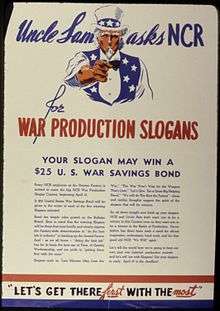
Two million units were sold by 1922, the year John Patterson died. In 1925, NCR went public with an issue of $55 million in stock, at that time the largest public offering in United States history. During the first World War, NCR manufactured fuses and aircraft instrumentation, and during World War II built aero-engines, bomb sights and code-breaking machines, including the American bombe designed by Joseph Desch.
Post-war
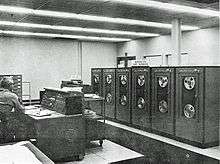
Building on its wartime experience with secret communication systems, high speed counters and cryptanalytic equipment,[17] NCR became a major post-war force in developing new computing and communications technology.
In 1953 chemists Barrett K. Green and Lowell Schleicher of NCR in Dayton submitted a patent "Pressure responsive record materials" for a carbon-less copy paper. This became US Patent 2,730,457 and was commercialized as "NCR Paper."
In February 1953, the company acquired the Computer Research Corporation (CRC),[18] after which it created a specialized electronics division. In 1956, NCR introduced its first electronic device, the Class 29 Post-Tronic, a bank machine using magnetic stripe technology. With the General Electric Company (now known as GE ), the company manufactured its first transistor-based computer in 1957, the NCR 304. Also in the 1950s NCR introduced MICR (magnetic ink character recognition)[19] and the NCR 3100 accounting machines.[20]
In 1962, NCR introduced the NCR-315 Electronic Data Processing System which included the CRAM storage device, the first automated mass storage alternative to magnetic tape libraries accessed manually by computer operators. The NCR 390 and 500 computers were also offered to customers who did not need the full power of the 315. The NCR 390 accepted four types of input: magnetic ledger cards, punched cards, punched tape, and keyboard entry, with a tape read speed of 400 characters a second.[20] The company's first all-integrated circuit computer was the Century 100 of 1968. The Century 200 was added in 1970. The line was extended through the Century 300.[21] The Century series was followed by the Criterion series in 1976, NCR's first virtual machine system.
During this period, NCR also produced the 605 minicomputer for in-house use. It was the compute engine for the 399 and 499 accounting machines, several generations of in-store and in-bank controllers, and the 82xx/90xx IMOS COBOL systems. The 605 also powered peripheral controllers, including the 658 disk subsystem and the 721 communications processor.
In 1974, NCR developed scanners and computers marked the first occasion where items with the Universal Product Code (UPC) was scanned at the checkout of a supermarket, Troy's Marsh Supermarket in Troy, Ohio; a few miles away from NCR's Dayton Headquarters. It was treated as a ceremonial occasion and involved a little bit of ritual. The night before, a team of Marsh's supermarket staff had moved in to put bar codes on hundreds of items in the store while NCR installed their scanners and computers.[22]
In 1982, NCR's Peripheral Products Division in Wichita, Kansas, together with peripheral manufacturer, Shugart Associates, helped propel the computer industry into a new era of intelligent standardized peripheral communications with the development the Small Computer System Interface (SCSI). The SCSI standard enabled such diverse devices as disks, tapes, printers, and scanners to share a common interface to one or more computer systems in a way that was never before possible and a model for subsequent interfaces to follow. NCR developed the world's first SCSI interface chip based on the SCSI interface standard collaboratively developed.[23]
By 1986, the number of mainframe makers had dropped from 8 (IBM and the "seven dwarfs") to 6 (IBM and the "BUNCH") to 4: IBM, Unisys, NCR, and Control Data Corporation.
The company adopted the name NCR Corporation in 1974.
Small computers
In 1982, NCR became involved in open systems architecture. Its first such system was the UNIX-powered TOWER 16/32, the success of which (approximately 100,000 were sold) established NCR as a pioneer in bringing industry standards and open systems architecture to the computer market. These 5000-series systems were based on Motorola 68k CPUs and supported NCR's proprietary transaction processing system TMX, which was mainly used by financial institutions. This product line also saw the first time NCR had offered its products through other than its own direct sales channels since the early 1900s. Formally added to its company structure in March 1984, NCR's OEM System's Division spearheaded the design, sales revenue and market awareness and acceptance of NCR's Tower family. Part of the cause of this success was the decision by NCR senior management to hire reseller industry veterans for key positions within the fledgling operation and have that unit work with, but not answerable to, NCR's traditional management structure. The industry shift from minicomputers brought personnel with minicomputer and reseller backgrounds such as the division head, Dan Kiegler (ex-Datapoint marketing), marketing manager and later Director of Field Sales, Dave Lang (ex-DEC reseller marketing director and salesperson) and other critical contributors at corporate levels; who then hired a complementary field sales organization primarily made up of proven people from DEC, Wang and other faltering minicomputer firms.
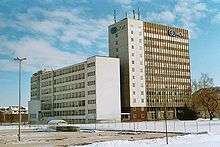
In the 1980s, NCR sold various PC compatible AT-class computers, like the small NCR-3390 (called an "intelligent terminal"). They proposed a customized version of MS-DOS named NCR-DOS, which for example offered support for switching the CPU between 6, 8 or 10 MHz speeds. The computers featured an improved CGA adapter, the NGA, which had a 640×400 text mode more suitable for business uses than the original 640×200 mode, with characters drawn using single-pixel-wide lines, giving an appearance similar to that of classic IBM 3270 terminals. The additional four-color 640×400 graphical mode was identical to CGA's 320×200 mode from a programming point of view.
NCR also manufactured two proprietary series of mini-to-midrange computers:
I-Series: 9010 (IDPS Operating System), 9020 and 9100 (IMOS Operating System), 9040 and 9050 (IRX Operating System), 9200 / 9300 / 9300IP / 9400 / 9400IP / 9500 / System 1000 models 35 / 55 / 65 / 75 (ITX Operating System). These were "I" (Interactive) computers allowing TTY terminals to be connected. Later models supported all industry-standard communication protocols.
V-Series: 8500 (VRX Operating System) and 9800 (VRX/E Operating System). These were "V" series, comparable to mainframes, supporting "Page mode" terminals. The hardware did have similarities with the I-Series while the operating system and user interface was totally different.
In 1990, NCR introduced the System 3000, a seven-level family of computers based on Intel's 386 and 486 CPUs. The majority of the System 3000 range utilised IBM's Micro Channel architecture rather than the more prevalent ISA architecture, and utilised SCSI peripherals as well as the more popular parallel and serial port interfaces, resulting in a premium product with premium pricing. The 3600, through NCR subsidiary Applied Digital Data Systems supported both the Pick Operating System and Prime Information.[24]
The 1970s saw the widespread installations of the Model 770 in National Westminster and Barclays banks throughout the UK, but it was not until the Model 5070, developed at its Dundee plant in Scotland and introduced in 1983 that the company began to make more serious inroads into the ATM market. Subsequent models included the 5084, and 58xx (Personas) series. In early 2008, the company launched its new generation of ATMs—the 662x/663x SelfServ series. NCR currently commands over a third of the entire ATM market, with an estimated $18 trillion being withdrawn from NCR ATMs every year. In addition, NCR's expertise in this field led the company to contract with the U.S. Military to support the Eagle Cash program with customized ATMs.[25]
NCR 5xxx series
The NCR 5xxx-series is the range of (ATMs) produced by NCR from the early 1980s. Most models were designed and initially manufactured at its Dundee factory in Scotland, but later produced at several other locations around the world.
There have been several distinct generations:
- 50xx-series; The initial models introduced in 1983 were the 5070 (interior vestibule) and 5080 (Through The Wall or TTW) introduced a number of features which have become standard among ATMs. Most notably, the individual functions of the ATM are divided among discrete modules which can be easily removed and replaced for repair or replenishment. The 5080 featured the standard anti-vandal smoked perspex screen which covered the keypad and screen until the cardholder inserted their card. The enhanced 5084 TTW model appeared in 1987, and had an improved anti-vandal fascia and was the first ATM to dispense with the need for the retracting perspex screen. The 5085 offered the first crude deposit function; with the machine supplying the deposit envelopes which were subsequently stored in the machine's safe for subsequent back office processing.
- 56xx-series; produced from 1991 to 1997. Enhanced functions such as color displays and improved security and usability functions became available. The introduction of Media Entry Indicators (MEI) which highlight the card entry slot to the customer was also a part of this series. Some 56xx machines produced between 1994–1996 were badged as "AT&T" rather than "NCR", mirroring the company's brief ownership under the telecoms giant in the mid-1990s. 56xx models have included the 5670 (interior lobby cash dispense only), 5675 (interior lobby multifunction—dispense & deposit), 5684 (exterior TTW dispense only), 5688 (exterior TTW drive-up multifunction) and 5685 (exterior TTW multifunction).
- 58xx-series marketed as Personas from 1998 to the present. These models were characterised by the gradual move towards greater ATM functionality including intelligent, envelopeless deposit by means of automated cheque recognition modules, coin dispense, and electronic cash recognition functions which allows bank customers to deposit cash and cheques with instant processing of the transaction. The 58xx series has also been characterised by the gradual introduction of LCD displays instead of the traditional CRT monitor. Models have included the 5870 (compact interior lobby dispense only), 5873 (interior lobby with cash accept & deposit only), 5874 (Exterior TTW cash dispense), 5875 (Multifunction TTW). The latest TTW versions of the Personas line, introduced in 2000 and marketed as M-Series added functions such as cash recycling, coin dispense, barcode reading, a larger 12" LCD display with touchscreen option, and for the first time, a common wall footprint for both the Multifunction (5886) or single function (5887).
NCR 66XX series
NCR's 6th generation of ATMs have been noted for the further move towards intelligent deposit and the expansion of secondary functions such as barcode reading.
- 667x-series marketed under the Personas M-Series brand were introduced in 2005 to the present. These models consist of the 6676 (interior lobby multifunction) and 6674 (through-the-wall multifunction). The outlook design is very different from the Personas model; on the front-access 6676s the front cover is opened upwards which claim to be saving the services area.
NCR Self-Serv 20 and 30 series
NCR's latest ATM services, introduced in 2008.
This series is a complete redesign of both outlook and technological contents. It is also a cost down product.
Self-Serv 20 series are single-function (e.g. cash-out) ATMs, while Self-Serv 30 series are full-function (cash-out and intelligent deposit) machines.
AT&T
Teradata
Teradata partnered with NCR in 1990 and was purchased by NCR in 1991.[26] Mark Hurd took over the company's Teradata division in 1999 and is credited with expanding NCR's Teradata business.[27] Hurd streamlined operations and invested in research. The Teradata division at NCR became profitable in 2002.[28]
Acquisition
NCR was acquired September 19, 1991 by AT&T Corporation for $7.4 billion and was joined with Teradata Corporation on February 28, 1992. As an AT&T subsidiary, its 1992 year-end headcount was 53,800 employees and contractors.[29] By 1993, the subsidiary produced a year-end $1.287 billion net loss on $7.265 billion in revenue. The net losses continued in 1994 and 1995, losses that required repeated subsidies from the parent company and resulted in a 1995 year-end headcount of 41,100.[29] During these three years, AT&T was the former NCR's largest customer, accounting for over $1.5 billion in revenue.[29]
On February 15, 1995, the company sold its microelectronics division and storage systems division to Hyundai which named it Symbios Logic. At the time it was the largest purchase of an American company by a Korean company.
For a while, starting in 1994, the subsidiary was renamed AT&T Global Information Solutions, but in 1995, AT&T decided to spin off the company, and in 1996, changed its name back to NCR in preparation for the spin-off. The company outlined its reasons for the spin-off in an Information Statement sent to its stockholders, which cited, in addition to "changes in customer needs" and "need for focused management time and attention", the following:
- ...[A]dvantages of vertical integration [which had motivated ATT's earlier acquisition of NCR] are outweighed by its costs and disadvantages....[T]o varying degrees, many of the actual and potential customers of Lucent and NCR are or will be competitors of AT&T's communications services businesses. NCR believes that its efforts to target the communications industry have been hindered by the reluctance of AT&T's communications services competitors to make purchases from an AT&T subsidiary.
NCR re-emerged as a stand-alone company on January 1, 1997.
Independence
One of NCR's first significant acquisitions after becoming independent from AT&T came in July 1997, when it purchased Compris Technologies, a privately held company in Kennesaw, Georgia that produced software for restaurant chains.[30] In November 1997, NCR purchased Dataworks Inc., a 60-person privately held company in San Antonio, Texas.[31]
The Montgomery County Historical Society and NCR Corporation joined in 1998 into a partnership committed to preserving the historic and voluminous NCR Archive. In 1999, NCR moved an estimated three million items from NCR's Building 28 into the Historical Society's Research Center.
In 1998, NCR sold its computer hardware manufacturing assets to Solectron and ceased to produce general-purpose computer systems, focusing instead on the retail and financial industries. In 2000, NCR acquired customer relationship management provider Ceres Integrated Solutions and services company 4Front Technologies. Recent acquisitions include self-service companies Kinetics, InfoAmerica and Galvanon, and software company DecisionPoint.
In April 2003, NCR purchased Copient Technologies, an Indiana-based retail marketing software company.
CEO Lars Nyberg announced his resignation from the company in February 2003 in order to address family matters. NCR promoted Mark Hurd to replace Nyberg as CEO in March 2003.[32] Early on in his new role, Hurd made changes in order to cut costs, including layoffs and converting an executive parking lot into an ATM training center. Within his first year as CEO, the company's stock doubled and NCR became a market leader in ultra high-end data-warehousing software.[33]
Under Bill Nuti's management

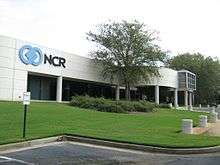
In 2006, NCR acquired software company IDVelocity and the ATM manufacturing division of Tidel, a cash security equipment manufacturer specializing in retail markets.
On January 8, 2007, NCR announced its intention to separate into two independent companies by spinning off Teradata to shareholders. Bill Nuti would continue his role as president and CEO of NCR, while Teradata Senior VP Mike Koehler would assume leadership of Teradata.[34] On October 1, 2007, NCR Corporation and Teradata jointly announced the Teradata business unit spin-off was complete, with Michael Koehler as the first CEO of Teradata.[35]
On January 11, 2007, NCR announced plans to restructure its entire ATM manufacturing operations, with 650 jobs at its Dundee plant being cut.[36] A further 450 jobs were cut in Waterloo, Ontario, Canada. In 2009, the Dundee manufacturing facility was closed, along with plants in São Paulo and Bucharest, citing global economic conditions.
NCR extended its self-service portfolio into the digital media market with the January 2007 announcement of NCR Xpress Entertainment, a multichannel entertainment kiosk. NCR's acquisition of Touch Automation LLC was announced on December 31, 2007.[37]
On October 15, 2008, NCR announced a global reseller partnership with Experticity, a Seattle based software company.[38]
In 2009, NCR relocated its corporate headquarters from Dayton, Ohio to near Duluth, Georgia; Dayton had served as NCR's home for 125 years.[39]
In 2009, NCR became the second largest DVD Kiosk operator in North America with the acquisitions of The New Release and DVD Play. In 2010, NCR completed the acquisition of digital signage company, Netkey.
In August 2011, NCR purchased Radiant Systems, a hospitality and retail systems company, for US$1.2 billion.[40] Radiant's hospitality division turned into a new Hospitality Line of Business within NCR. Radiant's petroleum and convenience retail business became part of its retail line of business. Several Radiant executives remained on board, including Scott Kingsfield, who was a general manager of NCR's Retail Line of Business and left NCR in 2014, and Andy Heyman, who became general manager of NCR's Financial Services line of business.
In August 2012, the company was hit with charges of avoiding U.S. economic sanctions against Syria, greatly affecting its stock price.[41]
In February 2013, NCR completed its acquisition of Retalix (NASDAQ: RTLX), a provider of retail software and services, for approximately $650 million in cash.[42]
In January 2014, NCR completed its acquisition of Digital Insight Corporation, a provider of online and mobile banking to mid-market financial institutions, from equity firm Thoma Bravo, LLC for $1.65 billion in cash.[43]
In September 2016, Mark Benjamin was named president and chief operating officer of NCR. Benjamin is a 24-year veteran of human resources management and will report directly to Bill Nuti.[44]
Mike Hayford becomes CEO
In January 2018, NCR relocated its corporate headquarters from near Duluth, Georgia to a new office in Midtown Atlanta. NCR's mailing address is 864 Spring St NW, Atlanta, GA 30308.[45]
In April 2018, Mike Hayford is named CEO. He leads the company's strategic shift from hardware provider to software- and services-led enterprise technology provider.
In 2019, NCR announced plans to start building a campus in Belgrade, Serbia.
Products and services
NCR's R&D activity is split between its three major centers in Atlanta (retail); Dundee, Scotland (financial industry); and Waterloo, Ontario. It also has R&D centers in Beijing; Cebu, Philippines; Belgrade, Serbia; Banja Luka, Bosnia and Herzegovina and Puducherry Chengalpattu and Hyderabad, India.[46] NCR also has manufacturing facilities in Beijing, Budapest, and the Indian territory of Puducherry and Chengalpattu which is a regional manufacturing and export hub.
Hardware

- Item Processing platforms (mainly checks) (7780, iTRAN 8000, TS)
- PCs (System 3000)
- Point of Sale (POS) for retail and food service
- POS Displays
- POS Printers
- POS Touch Screens
- POS Terminals
- NCR Silver, complete point-of-sale that runs on iPad, iPhone or iPod touch device
- POS Self Checkout (NCR SelfServ Checkout, formerly NCR FastLane)
- POS Scanners
- Self-service hardware, ATMs and kiosks (EasyPoint, Personas, SelfServ)
- Servers (S1600, S2600, System 5000, Tower)
Services
- E-business
- Education
- IT infrastructure services
- Managed services
- Payment
- Retail
- Self-service
- Payroll
Obsolete
- Class 1000 register
- Class 2000 bank posting machine (c. 1922–1973)
- NCR Voyager, an i386 SMP computer platform that preceded Intel's SMP specification.
- Electronic shelf labels (RealPrice – discontinued 2008)
- EasyPoint Mini, a touchscreen device originated by Copient Technologies
Senior management
- CEO: Michael Hayford[47] (April 2018 – present)
- CEO: Bill Nuti (August 2005 – 2018)
- CEO: Mark Hurd (2003–2005)
- CEO: Lars Nyberg (1996–2003)
- CEO: Jerre Stead (1993–1995) company renamed AT&T GIS
- CEO: Charles E. Exley, Jr. (1983–1993)
- CEO: William S. Anderson (1973–1984)
- CEO: Robert S. Oelman (1962–1973)
- CEO: Stanley C. Allyn (1957–1962)
- CEO: Edward A. Deeds (1931–1957)
- CEO: Frederick Beck Patterson (1922–1931)
- CEO: John H. Patterson (1884–1922)
- Interim CEO: Jim Ringler (2005)
- Interim CEO: Bill O'Shea (1995)
- Interim CEO: Gil Williamson (1993)
See also
References
- "Company Histories: NCR Corporation". Funding Universe. Retrieved February 25, 2009.
- Boone, Christian & Chapman, Dan (June 1, 2009). "NCR Move a Burst of Good News amid Recession: Georgia Spending $60 Million in Tax Breaks, Incentives To Attract Maker of Cash Registers, ATMs". The Atlanta Journal-Constitution. Archived from the original on June 5, 2009.
- "FORM 10-K". United States Securities and Exchange Commission. 31 December 2019.
- "Contact Corporate Governance". NCR Corporation. Retrieved February 9, 2014.
3097 Satellite Boulevard, Duluth, Georgia 30096
- "Duluth city, Georgia". U.S. Census Bureau. Archived from the original on December 28, 2011. Retrieved July 6, 2011.
- Belden, Thomas; Belden, Marva (1962). The Lengthening Shadow: The Life of Thomas J. Watson. Little, Brown and Company. pp. 157–8.
- Belden (1962) pp.84–87
- Streitfeld, David, "To Take Down Big Tech, They First Need to Reinvent the Law", New York Times, June 20, 2019. Retrieved 2019-06-20.
- Carson, Gerald (August 1966). "The Machine That Kept Them Honest". American Heritage. 17 (5): 52–54.
- Czerwinski, Allegra. "6 things you didn't know about NCR's John Patterson". dayton.com. Retrieved 4 February 2020.
- Biles, George E. (1993-01-01). "John henry patterson's contributions to industrial welfare". International Journal of Public Administration. 16 (5): 627–647. doi:10.1080/01900699308524815. ISSN 0190-0692.
- Bulletin of the United States Bureau of Labor Statistics. U.S. Government Printing Office. 1913.
- hurstvillemuseumgallery (2019-01-12). "Cash for council". Hurstville Museum & Gallery. Retrieved 2019-03-16.
- Sara Nicole England. "Ideal Citizens, Better Workers: National Cash Register Company’s Garden Programmes and Factory Tourism (1897–1913)." MA Thesis in the Department of Art History, Concordia University, Montreal, Quebec, 2018. https://spectrum.library.concordia.ca/984165/1/England_MA_F2018.pdf
- "John Henry Patterson (NCR owner)". wikipedia.org.
- Brevoort, Kenneth & Marvel, Howard P. (2004). "Successful Monopolization Through Predation: The National Cash Register Company" (PDF). In Kirkwood, J.B. (ed.). Antitrust Law and Economics. New York: Elsevier. Retrieved December 24, 2007.
- "Oral history interview with Robert E. Mumma". Charles Babbage Institute, University of Minnesota.
- Reilly, Edwin D. (2003). "Milestones in Computer and Science History". Greenwood Publishing Group. p. 164.
- "Oral history interview with Carl Rench". Charles Babbage Institute, University of Minnesota.
- "Electronic Computing Speeds Hycon Accounting Procedures". Hycon Hylights. Hycon Mfg. Company Monrovia, Calif. 8 (7). Sep 1962.
- "Product Information – NCR Century Processors NCR Century 300 Processor" (PDF). NCR Corporation.
- "The History of the Bar Code". Smithsonian Magazine.
- "The Chip Collection – NCR Collection, SCSI – Smithsonian Institution". smithsonianchips.si.edu.
- Computerworld 3 February 1992.
- Harris, Bryan (January 17, 2006). "Smart Cards, Kiosks Ease Army Life". Kiosk Marketplace. Archived from the original on November 13, 2006. Retrieved February 16, 2008.
- "10-K". www.sec.gov. Retrieved 2019-04-11.
- "NCR's CEO Resigns". CRN. Retrieved 2019-04-11.
- Schonfeld, Erick (2004-04-01). "The Wizard of POS". CNN. Archived from the original on 2006-05-17. Retrieved 2019-04-11.
- Information Statement. AT&T. November 25, 1996.
- "NCR Corp. To Buy Compris Technologies". Atlanta Business Chronicle. July 1997.
- "NCR Corp. Buys Dataworks Software Firm". Dayton Business Journal. November 1997.
- Rosencrance, Linda. "Mark Hurd to replace NCR CEO Lars Nyberg". Computerworld. Retrieved 2018-11-27.
- Schonfeld, Erick (2004-04-01). "The Wizard of POS ... As in point-of-sale, the battleground on which NCR CEO Mark Hurd is fighting to transform his venerable but creaking company into a modern-day technological powerhouse". CNN Money. Archived from the original on 2015-09-12.
- "NCR Announces Intention to Separate into Two Independent Companies" (PDF) (Press release). Archived from the original on January 17, 2007. Retrieved 2007-01-08.CS1 maint: BOT: original-url status unknown (link)
- NCR Completes Teradata Spin Off Archived 2007-10-18 at the Wayback Machine NCR. Retrieved on 2013-07-17.
- Scottish & Scotland news, UK & latest world news. The Daily Record. Retrieved on 2013-07-17.
- "NCR Announces 2008 First-Quarter Results, Including Record Year-Over-Year Revenue Growth" (PDF) (Press release). Archived from the original on October 10, 2008. Retrieved 2008-10-30.CS1 maint: BOT: original-url status unknown (link)
- "NCR and Experticity Announce Global Reseller Agreement" (Press release). Archived from the original on December 8, 2008. Retrieved 2008-12-10.CS1 maint: BOT: original-url status unknown (link)
- Ohio reels as NCR moves to Georgia. CNN. 2 June 1009.
- "NCR Completes Acquisition of Radiant Systems" (Press release). Radiant Systems. August 24, 2011.
- Harris, Bryan (October 14, 2012). "NCR investigating allegations of bribery, sanctions violation". Reuters. Retrieved October 31, 2012.
- "NCR Completes Acquisition of Retalix". Archived from the original on 2014-02-22. Retrieved 2014-02-09.
- "NCR completes acquisition of Digital Insight". Archived from the original on 2014-02-14. Retrieved 2014-02-09.
- Nicholas, Scott. "ADP Vet Mark Benjamin Joins NCR as President, COO; Bill Nuti Comments". Govcon Wire. Retrieved 17 November 2016.
- "NCR Offices". NCR. Retrieved 2018-07-05.
- NCR Corporation unveils largest R&D facility outside US in Hyderabad. Times of India (2017-11-10). Retrieved on 2013-09-27.
- "Michael Hayford". NCR.
External links
| Wikimedia Commons has media related to NCR Corporation. |